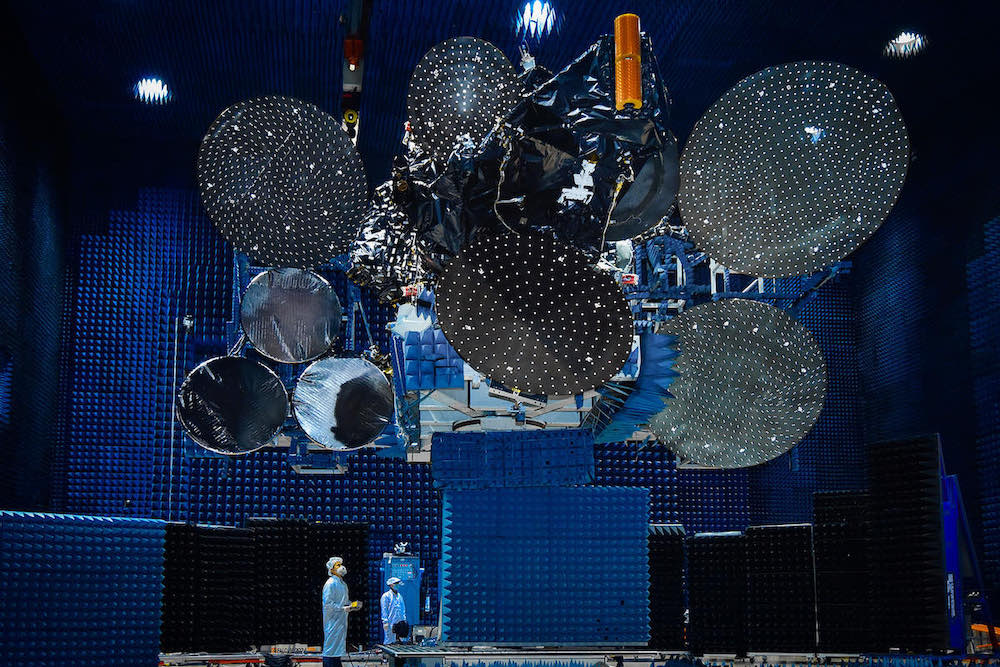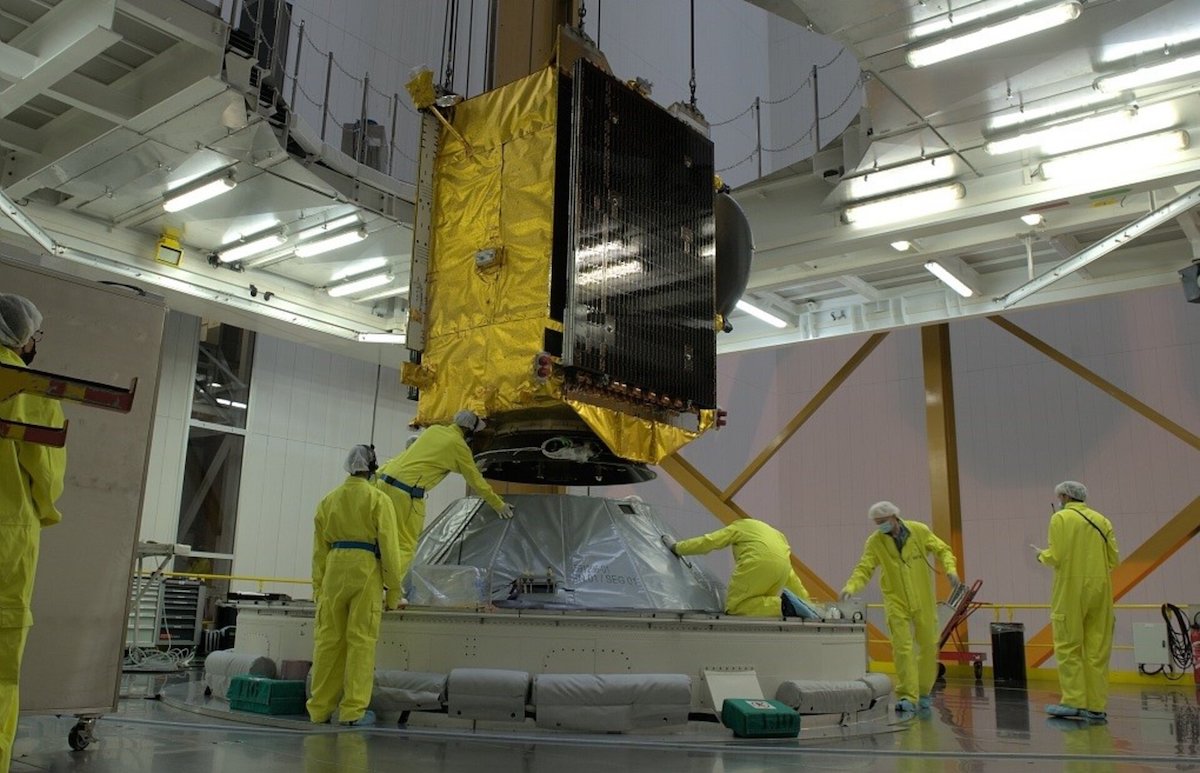
A European Ariane 5 rocket launched from French Guiana Friday, succeeding on its first flight in nearly a year to deploy a pair of geostationary communications satellites for commercial operators in Brazil and France.
The launch was a key test of the Ariane 5 rocket ahead of a flight later this year to send the James Webb Space Telescope toward its observation post nearly a million miles from Earth. The European Space Agency is providing the launch for JWST, a joint program between NASA, ESA, and the Canadian Space Agency with a cost of more than $10 billion.
Engineers introduced modifications to the Ariane 5’s payload fairing, or nose cone, to reduce vibrations imparted on the satellites during separation of the shroud, which protects payloads during the first few minutes of flight through the atmosphere.
Ground teams will analyze data from the rocket to make sure the changes reduced the vibrations. Another Ariane 5 launch is scheduled for late September, then JWST will be next in line for a liftoff in November or December.
The Ariane 5 is one of the most powerful rockets in the world. Friday’s mission marked the 110th flight of an Ariane 5 rocket since 1996, but it was the first Ariane 5 launch since last August, an unusually long gap between missions to allow engineers to resolve the fairing vibration concern before the launch of JWST.
Technicians at a Northrop Grumman facility in Southern California are readying the observatory — the largest space telescope ever flown — for shipment by boat to the Guiana Space Center.
But first, the Ariane 5 team had to successfully launch two commercial communications satellites Friday.
Thomas Zurbuchen, head of NASA’s science mission directorate, attended the launch Friday in French Guiana. NASA Administrator Bill Nelson said in an interview Thursday that the agency sent Zurbuchen to the Guiana Space Center to check on preparations for the JWST launch.
“We sent Dr. Thomas Zurbuchen down to French Guiana because it seems the only hold up that we would see with James Webb would be whether or not these two Arianes that fly before JWST, if they get off safely and on time,” Nelson said. “And we wanted Dr. Z t to go down there and check all of that out, so he’ll report to us on what he sees.”
The Ariane 5 rocket, standing nearly 180 feet (55 meters) tall, took off from the European-run spaceport in South America at 5 p.m. EDT (2100 GMT; 6 p.m. French Guiana time) with Embratel’s Star One D2 spacecraft and the Eutelsat Quantum satellite.
A hydrogen-fueled Vulcain 2 main engine and two solid rocket boosters propelled the launcher off the pad. The Ariane 5’s guidance computer put the rocket on a path east from French Guiana, and the rocket shed its spent booster casings nearly two-and-a-half minutes into the mission.
About a minute later, ground controllers confirmed separation of the Ariane 5’s payload fairing.

The core stage engine burned for almost nine minutes, then jettisoned to fall into the Atlantic Ocean near Africa. A cryogenic upper stage ignited to finish the job of placing the Star One D2 and Eutelsat Quantum satellites into orbit.
Arianespace, the French launch services company, confirmed a good orbital injection and separation of both satellites less than 40 minutes after liftoff.
Star One D2 is a multipurpose communications satellite covering Latin America for Embratel of Brazil. Built by Maxar in Palo Alto, California, the spacecraft rode in the upper position of the dual-satellite stack inside the Ariane 5’s payload fairing.
Fully fueled, the satellite weighed 13,646 pounds (6,190 kilograms) at launch, according to Arianespace. The spacecraft carries transponders operating in Ku-, Ka-, C-, and X-band frequencies, allowing it to serve multiple missions from its perch in geostationary orbit more than 22,000 miles (nearly 36,000 kilometers) over the equator.
Embratel says the new satellite, designed for a 15-year lifetime, will allow it to expand broadband coverage to new regions in Central and South America, support television broadcast programming, and provide cell phone backhaul capacity. The satellite’s X-band payload will be used by the Brazilian military.
Maxar said in statement after the launch Friday that the Star One D2 satellite was performing as expected after separation from the Ariane 5 rocket. The spacecraft deployed its solar arrays and began communicating with mission control through ground stations.
Star One D2 will execute several thruster firings over the next few weeks to maneuver out of the elongated transfer orbit the Ariane 5 rocket placed it in. The satellite will target a circular geostationary orbit, where its speed will match the rate of Earth’s rotation, and enter service at 70 degrees west latitude.
“Maxar is proud of our partnership on geostationary satellites with Embratel over the years,” said Chris Johnson, Maxar’s senior vice president of space programs delivery. ‘Our team members completed building Star One D2 during the global pandemic, which added in new and unusual working conditions to keep everyone safe. They persevered and delivered the satellite, and we’re now focused on its on-orbit commissioning activities.”
The Eutelsat Quantum spacecraft, built by Airbus in France, rode to orbit in the lower position inside the Ariane 5’s payload shroud.
Developed in a public-private partnership between ESA, Airbus, and Eutelsat, the spacecraft will debut a new software-based design that will allow the satellite to be completely reprogrammed in orbit.
The innovation is a first for a European satellite, and will give Eutelsat the flexibility to repurpose the Quantum spacecraft to respond to changing market demands over its 15-year design life.

Like Star One D2, he 7,630-pound (3,461-kilogram) Eutelsat Quantum spacecraft will head into geostationary orbit after separation from the Ariane 5 rocket’s upper stage. Its service location will be at 48 degrees east longitude.
The satellite will operate in Ku-band with eight independent reconfigurable beams, allowing Eutelsat to adjust the spacecraft’s throughput and coverage zones to meet ever-changing business requirements.
“Its beams can be redirected to move in almost real time to provide information to passengers on board moving ships or planes,” ESA said in a press release. “The beams also can be easily adjusted to deliver more data when demand surges. The satellite can detect and characterize any rogue emissions, enabling it to respond dynamically to accidental interference or intentional jamming.”
Pascal Homsy, Eutelsat’s chief technical officer, said ground teams established contact with Eutelsat Quantum after launch Friday night.
“Eutelsat Quantum is, indeed, a game changer,” Homsy said after launch. “It’s a satellite of a new time, a flexible satellite which will be able to be controlled in orbit from the ground through software. That is a great advantage for our clients, so coverage and power, spectrum and capacity are going to be reconfigurable any time.’
Email the author.
Follow Stephen Clark on Twitter: @StephenClark1.
